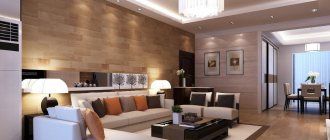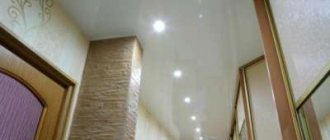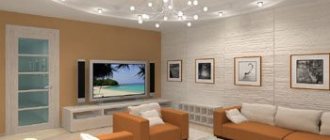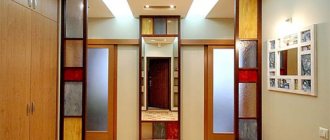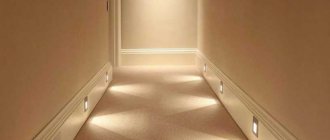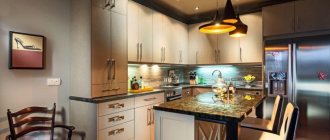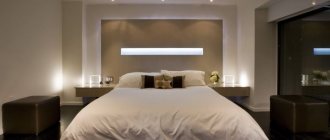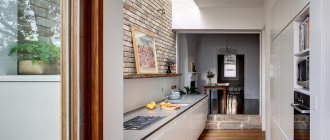Norms and requirements
Despite moving quickly along the corridor, the lack of light can cause a number of inconveniences, as well as its excessive intensity. In this matter, the easiest way is to navigate through adjacent rooms so that a single space is created without sharp changes and contrast.
A number of other rules should also be noted:
- In accordance with the requirements of SanPiN 2.2.1/2.1.1.1278-03 and SP 52.13330.2011, the illumination level in the corridor must be at least 50 Lux. And in places of increased visual load - at least 300 Lux.
- Based on clause 6.6.31 of the PUE, switches for switching lighting devices should be placed at a height of 0.8 to 1.7 m relative to the floor.
- According to clause 7.1.51 of the PUE, the switch must be located on the side of the door handle at the entrance. However, if, in addition to the main lighting in the corridor, other local lighting is used, their switches can be installed in the appropriate zones.
- In accordance with clause 1.7.51 of the PUE, all conductive elements of the luminaire design in normal operation must be connected to protective grounding.
- The location of lighting devices should be as safe as possible so that a person in the room does not catch them.
No. 1. What basic rules should you follow?
When choosing light sources and a place for them, you should follow some rules that will help bring comfort and coziness to the room. So, the basic requirements for hallway lighting are as follows:
- the light should not be dim, as it will be impossible to find the necessary item or examine your reflection in the mirror before leaving;
- the other extreme, too bright light, is also inappropriate, as it will highlight all the shortcomings of the repair and decoration, and when entering from a dark entrance it will hurt the eyes;
- the optimal level of lighting in the hallway - the same as in neighboring rooms , so that the whole apartment becomes a single harmonious space. In order for the lighting to be approximately the same both during the day and in the evening, several light sources are provided in the hallway;
- the best option is diffused light , which is achieved through the use of matte shades for sconces and chandeliers, as well as by directing the rays upward so that they are reflected from the light ceiling finish and create uniform, sufficient lighting;
- hanging lampshades in hallways that are not too high and sconces that are too low - the risk that they can be caught by a hand or parts of clothing when changing clothes.
Selection of lighting fixtures
Thanks to the development of lighting equipment, today you can easily implement any interior design trend.
Among such devices, several categories should be distinguished:
- ceiling lamps - designed for general lighting in the corridor; ceiling-mounted, built-in or suspended options can be used, depending on the type of ceiling and its height;
- wall lamps - used to decorate space, local lighting in the place where you experience visual strain;
- spotlights - equally well suited for local and general lighting, also used as decorative lighting;
- spots - used for directional lighting design of any objects in the corridor (mirrors, paintings and other functional areas);
- LED strips, duralights, neon cords are used as LED lighting, which, depending on the power of the luminous flux, can both provide basic lighting and perform decorative functions.
Additional wall lighting
This element is not necessary, but with its skillful use the hallway becomes more beautiful and cozy. Light bulbs on the walls will complement the ceiling lighting.
Sconces are often hung on the sides of the mirror. This way the face is illuminated more evenly, without shadows from below.
If there is a shelf for small items or a hanging key holder, it is useful to highlight it too. Lighting for paintings and photographs can also be placed on the wall, but it is better from above, directing the light beam downwards. A spot or small narrow LED lamp will do.
Mounting options
Both the coverage area and the reliability of operation of the equipment itself will depend on the installation location and method of fastening artificial lighting devices.
Depending on the installation location, mounting options are divided into:
- ceiling lamps;
- wall sconces;
- floor;
- mounted in furniture.
In addition, all corridor lighting devices can have a suspended mounting method, surface-mounted or built-in. Please note that long oversized lampshades hanging from the ceiling or lagging behind the wall should take into account the height and width of the room so that they do not interfere with your free movement around it.
According to the method of fastening, all corridor lighting devices are divided into:
- fixed with dowels;
- bracket mounted;
- pasted on double-sided tape.
The first two methods are suitable for surfaces made of durable hard material. For gluing, the main criterion is the ability of the surface to adhere to the glue.
Color games
Experienced designers warn against crossing the line of “excess” when decorating interiors in red tones. Your task is to “tame” the violence of the fundamental tone. This can be done by introducing other shades of the rainbow palette into the decor of the red hallway . The ideal partner for red will be white. They will cope well with the task:
- Beige.
- Ivory shade.
- Grey.
- Caramel.
- Gold.
- Silver.
The red rug in the hallway matches perfectly with the color of the front door
A competent approach to the use of this extraordinary color in all respects will allow you to create a red hallway of incredible beauty.
Moreover, the color you choose does not necessarily have to be introduced into the decor directly, that is, in a classic tone; it can be quite worthily replaced by other representatives of the red spectrum. A hallway in other shades of red will get a more refined and austere look: coral, brick, terracotta or Venice. The above light colors can also dilute and shade them.
Features of lighting corridors of different shapes
Depending on the layout of the home, there are both narrow extended and spacious hallways, which represent a full-fledged room. Accordingly, the lighting of each of them is organized taking into account the geometric parameters and needs of the residents.
Long
Due to the long perimeter of such a corridor, one central chandelier may not be enough, since the light will be localized at a certain interval. It is much more profitable to install several point sources along the entire length of the ceiling or complement the chandelier with several wall spots. The floor can be highlighted with decorative lighting, creating the effect of a runway. To make it easier to turn the lighting on and off in a long corridor, you can place walk-through switches on one or the other side of the entrance.
Narrow
The main problem of a narrow corridor is the psychological discomfort of being in a confined space, which in most apartments is additionally cluttered with hangers, furniture or outerwear. Therefore, lighting in a narrow corridor should be aimed at visually expanding the space.
To do this, they use the effect of reflection and counter-arrangement of low-power LED lamps, creating light zones in those places where you want to emphasize. It is important to take into account the location of all elements that may interfere with the distribution of light.
L-shaped
A feature of L-shaped corridors is the presence of two territorially delimited zones, the arrangement of which can be carried out both jointly and independently of each other. If a small section of the corridor receives uniform lighting from the next room, then you can increase the luminous flux from the hallway by placing a wall lamp opposite. If in an L-shaped room the area around the bend is long, then it would be more expedient to install several lamps or an LED strip along the contour of the ceiling.
Square
In a square corridor you immediately feel an excess of space, which is why you can easily lose space when the walls of the room are lost when lighting accents are turned on. This problem can be solved by installing pendant chandeliers, which will provide uniform lighting along the entire perimeter of the corridor. In addition to the chandelier, you can install several spotlights in the ceiling space. However, this does not mean that you should do without light zones in functional areas.
Low ceiling
In a low corridor, installing pendant chandeliers would be inappropriate; not only will the light not be able to provide effective illumination, but you also run the risk of hitting the structure with your head as you pass by. Here you can place ceiling-mounted plate chandeliers or install sconces and wall spots.
With high ceiling
Ceiling chandeliers located at a great height from the floor will illuminate the ceiling itself, but only a small fraction of the light will reach functionally important areas. Therefore, all lighting fixtures must be lowered a certain distance so that the light accent moves to the lower part of the room. The same effect will be provided by wall lighting fixtures along the perimeter of the corridor; without a central lamp, they will help hide the shortcomings of the upper finish.
No. 2. Zoning with light
Even in the tiniest hallway it would be nice to highlight several different light sources. This will make it possible to turn on only those lamps that are really necessary in each specific case and create suitable lighting every time. If the hallway is of normal size, then it doesn’t hurt to provide switches in different places so as not to walk through the dark looking for it, but to be able to turn on the light from the living room, for example.
light accents in the hallway . So, the most illuminated place can be the entrance area, where household members and guests dress, put on shoes, etc. The accent can be placed near the doors to the living room, and the light will seem to invite you to enter. The remaining doors leading to bedrooms and other rooms do not need to be illuminated.
In the hallway it would be nice to highlight the following types of lighting:
- general , which is included at the entrance;
- local , which is necessary for illuminating important areas in the hallway, incl. mirrors, cabinets, etc.;
- decorative , it will decorate the room, highlight some interesting elements and even allow you to visually make the hallway more spacious.
Features of lighting depending on the ceiling material
Installation work and the principle of light supply in the corridor also depend on the condition of the ceiling surface. It is important to take into account the reflective or absorptive ability of the latter.
Tensioner
The design of any stretch ceiling provides you with a perfectly flat plane that perfectly reflects light. Both built-in models of lighting devices, hidden behind the canvas, and installed below the ceiling would be appropriate here.
However, in practice there are three types of suspended ceilings:
- Glossy - perfectly reflect the light flux, so you can reflect light from them to the entire space of the corridor. But, at the same time, they will reflect light bulbs and dots from the LED strip located along the perimeter of the ceiling.
- Matte - despite the texture being close to conventional whitewash, they do a good job of reflecting and redistributing light. But reflected dots and other effects will no longer be visible on them.
- Satin - their reflective ability is somewhere in the middle between glossy and matte. However, this option has brilliant inclusions that make for a fun game.
Plasterboard
Suspended ceilings have a good amount of space in which you can place lighting fixtures. Both recessed and pendant lamps are equally appropriate here, but the latter must be mounted on a butterfly dowel or directly under the metal profile. Most plasterboard structures are covered with wallpaper or painted with matte paint, so they absorb much more light than they reflect.
Lighting up a small hallway
Even the smallest space should have local and general light. Traditionally, the main source of light in a small area is a ceiling chandelier. This is a classic lampshade with one light bulb. A more modern option is spotlights mounted in the suspended ceiling system.
When thinking about which lamps to choose for installation in small hallways, remember that in the selected models the light rays were directed upward. This way you can achieve the visual effect of no boundaries between the wall and the ceiling.
Organization of general lighting
This function can be assigned to both a chandelier and spotlights. The main criterion for which will be to ensure sufficient brightness of lighting. This does not mean that you will easily read a newspaper; such luminous flux power is unnecessary here; it is enough to distinguish all the elements of the interior well enough. Installation of LED spotlights or chandeliers should be carried out according to a pre-designed lighting scheme so that the fastening elements do not damage the wiring lines. If the hallway is long enough, you can install several chandeliers in a row, dividing the entire space into several conventional zones.
Spotlights in the hallway
Nowadays, people rarely limit themselves to simply purchasing and installing a lamp after repairing the ceiling. Owners of modern apartments strive to create an efficient, functional and practical interior, and for this they plan various kinds of lighting schemes.
The most important element of home lighting design are spotlights, which, together with traditional overhead lighting, create a harmonious, cozy atmosphere and divide the corridor into zones. How functional and aesthetic the general and spot light will be depends on how correctly the lighting equipment is placed.
If lamps are installed in a large hall, spot lights should be arranged in groups so that each one “bestows” light on a separate area.
For example, you can separately illuminate the following zones:
- Recreation;
- Works;
- Watching a movie.
You can really increase the effect with the help of floor and wall lighting devices. In some cases, you can even do without main lighting, but this option is more suitable for a bedroom than for a living room or kitchen.
As for the corridor, it is best if there is general light in the form of 2-3 overhead lamps, as well as spot lighting. LEDs are good for lighting niches, shelves and mirrors. If you place an LED strip along the walls of a narrow corridor, it will visually appear wider and more spacious.
In new buildings and old houses, the corridor is narrow and dark. You can make the hallway more spacious and brighter with the help of a glossy hanging structure.
Organization of local lighting
In addition to the main lighting, in some corridors it would be appropriate to organize local lighting for the comfort of the interior or the design of a functional area. Next, we will consider the most relevant positions for such zones.
Mirrors
A mirror in the hallway helps you complete the finishing touches before leaving the house, fixing your hair or assessing how a new dress fits. Therefore, visibility in this area should be sufficient for applying makeup and performing minor work. To illuminate the mirror, you can install several sconces on the walls on both sides or one spot on top. If the mirror in the hallway is part of the furniture hallway, you can embed a rotating soffit above it.
Paintings
Decorating a hallway with paintings, photographs, or framed displays is a great design option. And to see them in pitch darkness you need to use night lighting. The best option is directional lighting devices installed on top of the paintings; matte shades are used for them so that the light does not create glare on the surface of the painting. In some hallways, picture lighting can be mounted on the ceiling.
shelves
Shelves, as a place to store some things, clothes or shoes, can be decorated with a lamp with a decorative shade, built-in spotlight or LED strip. Regardless of the location of the shelf itself, an important criterion for its lighting will be the direction of the lighting flow so that the light does not blind those nearby.
Stairs
The staircase adjacent to the corridor is illuminated with side or front lamps on each step or every few. You can also place a central chandelier or sconce away from the wall. An important requirement is the direction of the light flow, in which the lighting should not blind anyone entering the corridor or moving along the stairs.
Let's talk about difficulties
When organizing lighting for the corridor with their own hands, many people are faced with certain problems that this room has. The fact is that the hallway in the house plays a dual role:
- is the beginning of a home, by the appearance of which guests and friends can judge its owner;
- is a place where owners clean themselves up before going out.
Hallway option
Sometimes it is difficult for a room to fulfill both roles due to its characteristics. Often, the hallway in our houses, which most often represent an apartment in an apartment building, is characterized by the following points:
- a small room that often has twists and turns;
- the corridor has no windows. The only way for natural light to enter it is through the doors from the rooms and kitchen.
As you can see, lighting in this area of the apartment is very important. This is due to the fact that in order to meet the standards for the level of illumination, it is necessary to install lamps here, the need for which is present throughout the day, and not just at night or in the evening. Of course, in private houses or apartments of a certain type there are spacious hallways where you can roam around both in its interior design and in the use of certain lighting fixtures. But in order to efficiently illuminate a small hallway, you need to try and choose the most optimal model.
Decorative lighting
Used to decorate a corridor or highlight its individual components. The most suitable options are to install LED strip or flexible neon around the perimeter of the ceiling, in the floor plinth, under doorways, furniture or photo frames. You can also use spotlights above vases, chests of drawers, shoe racks in the hallway, and built into the wall at floor level they will help replace night lights.
Useful tips from experts
Choose interior doors with glass inserts. This way you can let in a sufficient amount of natural light from the living rooms into the hallway.
Pay attention to the light with a motion sensor. This is a very easy-to-use and practical device that allows you to save energy without personal intervention. Today, such lamps have become affordable for the masses of consumers. This device is quite easy to install on your own.
Use decorative lighting. Mounted not on the ceiling, but along the perimeter of the floor, it allows you to achieve a very interesting decorative effect. In this original way you can get rid of the feeling of enclosure in the room.
For long hallways, a good solution to help diversify the monotonous surface of the walls would be elements of artistic art, illuminated with pointed light. Empty walls can be used as display space for handmade items.
Existing niches or overhangs also require lighting. To do this, use a turned lamp located along the upper contour of the element.
When buying light bulbs, you need to pay special attention to their color. The most visually pleasing is the yellow incandescent lamp. The cool color of the lamp makes the room uninhabited.
